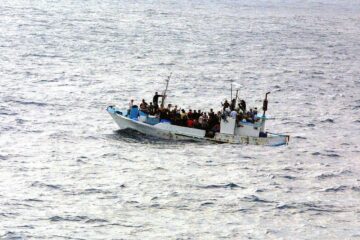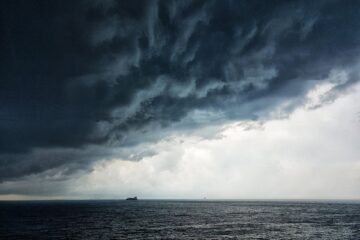![]()
Introduction:
The International Tribunal for Law of the Sea was established by the 1982 United Nations Convention on the Law of the Sea. It is an independent judicial body that has jurisdiction in matters of interpretation and application of the Convention or in a matter where an agreement provides the jurisdiction to this tribunal. Some of the disputes covered under the Convention include conservation and management of living creatures of the sea, delimitation of maritime zone, marine environment and research work.
History of the Tribunal
The establishment of this Tribunal originates from the implementation of the United Nations Convention on the Law of Sea, so it is important to understand the origin of this Convention.
The thought of this Convention originated after the Ambassador of Malta, Arvid Pardo addressed the UN General Assembly for the requirement for an international regime which has its jurisdiction over the seabed and oceans. The result was convening of the Third Nations Conference on Law of the Sea in 1973 and after negotiations of nine years, on 10th December 1982 the Convention was open for signatures at Montego bay, Jamaica. It came into force on 16th November 1994.
The Convention is providing a legal framework which regulates oceans. It includes provisions pertaining to exclusive economic zones, territorial sea, contiguous zone as well as continental shelf. Under this United Nations Convention, four dispute resolution alternatives have been established and one of them is the International Tribunal for the law of Sea.
The timeline of ITLOS goes along with the UN Convention itself. It was on 15th July that the Convention’s first consolidated text was presented where dispute settlement system was considered as an integral part of the convention and this adjudicatory body was named the International tribunal for Law of Sea on 22nd September 1980. The Conference chose the seat of the Tribunal in Hamburg on 21st August 1981 and all these decisions were taken in New York. The Preparatory committee had its first meeting on 15th March 1983 in Kingston to discuss issues relating to the establishment and working of the Tribunal.
The first set of 21 Judges for the Tribunal were elected in the Fifth Meeting of the State Parties to the Convention on 1st August 1996 in New York. These Judges elected the first President and Vice-President of the Tribunal on 5th October 1996 in Hamburg. The first President was Thomas A. Mensah from Ghana and the Vice-President was Ruediger Wolfrum from Germany. The then Secretary-General of United Nations Dr. Boutros Boutros-Ghali graced his presence at the ceremonial inauguration of the Tribunal on 18th October 1996 and Gritakumar Chitty from Sri Lanka was made the first the first Registrar of the Tribunal on 21st October 1996.
Composition
President
The President of the Tribunal is elected through a secret ballot for a term of three years and can be re-elected. The main duty of the President is to direct work and supervise the administrative work. It also acts as the representative of the Tribunal in relations with states and other entities and all meetings of the Tribunal are presided over by them. If there is an equality of vote, the President can also cast a vote. They are the ex-officio member of the Chamber of Summary Procedure and if they are a member of any special chamber, they can preside over it as well.
Vice-President
The Vice-President is also elected through a secret ballot for a term of three years and can be re-elected. They are responsible for exercising the function of a President if there is a vacancy or the President is incapable of discharging their functions. The vice-president is also the ex-officio member of the Chamber of Summary Procedure and if they are the member of a special chamber which does not have the President, they can preside over the Chamber.
Members
The Tribunal has 21 independent members who are elected by the state parties to the convention through a secret ballot. Each party to the Convention nominates two candidates based on the highest reputation and recognized competence in this field of law for fairness and integrity. In the Tribunal no two members can be of the same State because it needs to keep in mind the representative factor of various legal systems, and geographical groups as have been previously established by the General Assembly of the United Nations like African States, Asian States etc. Each of the member is elected for nine years and every three years the term of one-third of these members expire. These members can be re-elected.
Judges ad-hoc
A party can choose their own person as the judge, if the Tribunal or chamber does not include a judge of the nationality who is a party to the dispute. A judge ad hoc is taken when they fulfil the requirements as given in Article 2, 8 and 11 of the Statute. The chosen through complete equality and participate in the case they are chosen for. Some of the cases for judges ad hoc have been chosen are Southern Bluefin Tuna Cases (New Zealand v. Japan; Australia v. Japan) where Ivan Shearer was nominated by Australia and New Zealand. Another one was The “Grand Price” Case (Belize v. France) where Mr. Jean-Pierre Cot was chosen by France.
Dispute Settlement & Chambers
It is already known that this Tribunal is one of the four alternatives for dispute resolution. A State Party is free to choose the Tribunal out of the four alternatives just that it has to get a written declaration deposited with the Secretary-General under Article 287 of the Convention. The Tribunal can be approached by all States parties to the Convention and there are certain cases where other entities such as international organization or individual person can also access the Tribunal.
In accordance to the provisions of the Statute, special chambers have been formed by the Tribunal which are Chambers of Summary Procedure, the Chamber of Fisheries Dispute, the Chamber for Marine Environment Disputes and Chamber for Maritime Delimitation Disputes. Tribunal, on request of parties, has formed special Tribunals for cases like Case concerning the Conservation and Sustainable Exploitation of Swordfish Stocks in the South-Eastern Pacific Ocean, Dispute concerning delimitation of the maritime boundary between Mauritius and Maldives in Indian Ocean etc. These Chambers derive their authority from Article 15, paragraph 2 of the Statute.
Seabed Disputes Chamber & Ad hoc Seabed Disputes Chambers
This Chamber was formed in accordance to Part XI, Section 5 of the Convention and Article 14 of the Statute and has its Jurisdiction in International Seabed Areas. There are 11 judges in this Chamber who are selected by the members of the Tribunal every three years. The President of the Chamber is elected by its members as given in Article 15 of the Statute. An ad hoc Seabed Chamber can be formed at the request of any party in the dispute and it has three members. These members are not necessarily in service or nationals of the State party and details pertaining to this have been stated on the Article 37 of the Statute.
Chamber of Summary Procedure
This Chamber has been formed under Article 15, paragraph 3 and 4 of the Statute and it functions to hear and determine a case based on summary procedure on the parties’ request. Another of its function is to give out provisional measures if the tribunal does not have a session or does not have the required members. The composition of this Chamber is five members and two alternates.
Chamber for Fisheries Disputes & Chamber of Marine Environmental Disputes
Both have been established under Article 15, paragraph 1 of the Statute. The former functions to handle disputes pertaining to management and conservation of Marine resources. The latter aims it resolving disputes pertaining to the protection and preservation of Marine environment. Both have a composition of nine members.
Chamber for Maritime Delimitation Disputes
This Chamber is also established under Article 15, paragraph 1 of the Statute and works to resolve disputes on Maritime delimitation. It has a composition of 11 members.
Jurisdiction
A case which has been submitted to the Tribunal pertaining to Part XV of the Convention and concerns the interpretation and application of the Convention or regarding implementation of Part XI of the Convention comes under its jurisdiction. Disputes which have been referred in Article 297 and 298 of the Convention and can also be submitted to the Tribunal. At the international level also, in accordance to Article 288 of the Convention and Article 21 of the Statute, the Tribunal has jurisdiction on application and of various international agreements which relate to subjects provided in the Convention. The Tribunal itself decides if it has the jurisdiction to settle a matter and this authority is derived from Article 288 of the Convention. The Tribunal may also give some provisional measures under Part XV and XI, Section 5 if it deems it right under the given circumstances to preserve the rights of the parties. This has been stated under Article 290 of the Convention and Article 25 of the Statute. The jurisdiction of the Tribunal also lies in prompt release of detained vessels or crew by accepting application as given in the Article 292 Convention. This application can only be made by the State whose flag is there on the detained vessel.
The jurisdiction of the Seabed Disputes Chamber lies over disputes in areas which have been mentioned in Article 1 of the Convention and Article 187 (a) to (f) of the Convention. But they don’t have a jurisdiction to exercise the role of International Seabed Authority or question if any rules or procedures established by the Authority are against the Convention and announce them invalid.
Advisory Functions & Decisions of the Tribunal
The Tribunal also plays an advisory role where the Seabed Dispute Chamber can give opinions on the request of Assembly or Council of International Seabed Authority as given in Article 159 of the Convention. An advisory opinion can also be given by the Tribunal on the legal question if Tribunal receives submission of an international agreement which deals with subject of Convention which requests for such opinion. The decisions of the Tribunal are based on if they are cases of provisional measures and prompt releases or judgement or advisory opinions, but all decisions are final and binding. The cases of provisional measures and prompt release are generally completed in 30 days while later takes up to 2 years.
Procedure
The working of the Tribunal including its guidelines and proceedings of the cases are based on the Convention, Statute of the Tribunal, Rules of the Tribunal, Resolution on the Internal Judicial Practices of the Tribunal and Guidelines concerning Preparation and Presentation of Cases before the Tribunal. The Rules and Guidelines came into force on 28th October 1997while the Resolution was adopted on 31st October 1997. The proceedings of the case have two stages that are the oral and written. They have been explained in the Article 44, paragraph 1 and 49 of the Rules of the Tribunal. The tribunal functions with its official languages being English and French. All documentation and notifications regarding cases are submitted addressing to the Registrar who is the medium of communication and these communications have to be sent to agents who have their base in Hamburg or Berlin.
Relationship with United Nations
The relationship of the Tribunal with the United Nations includes its agreements with various other elements of the UN. The Tribunal though formed under a UN Convention is not an organ of the UN rather it has signed an Agreement on Cooperation and Relationship between United Nations and the International Tribunal for the Law of Sea. The Tribunal was granted an observer status by the UN General Assembly in its 51st Session which led to Tribunal being allowed to participate in meeting of UNGA when the topic of discussion was in relation to matters the Tribunal has jurisdiction over. The Tribunal also has an agreement with the United Nations Appeal Tribunal which the President of ITOLS signed on 23rd June 2010 and Secretary-General signed on 13th July 2010. The basis of this agreement are to extend the competence of the latter to the Tribunal if terms of appointments and contracts Registry employees are in question. The Tribunal is also a participant of the International Civil Service Commission which is an independent body formed by UNGA since 2016.
Present Composition of the Tribunal
The present members elected by the Tribunal would remain in term till 2023. The President at present is Albert Hoffman from South Africa and the Vice-President is Tomas Heider from Iceland. Other members include Jose Luis Jesus (Cabo Verde), Stanislaw Pawlak (Poland), Shunji Yanai (Japan), James L. Kateka (Tanzania), Boualem Bouguetaia (Algeria), Jin-Hyun Paik (Korea), David Joseph Attard (Malta), Markiyan Z. Kulyk (Ukraine), Alonso Gomez-Robledo (Mexico), Oscar Cabello Sarubbi (Paraguay), Neeru Chadha (India), Kriangsak Kittichaisaree (Thailand), Roman Kolodkin (Russia), Liesbeth Linjzaad (Netherlands), Maria Teresa Infante Caffi (Chile), Jielong Duan (China), Kathy-Ann Brown (Jamaica), Ida Caracciolo (Italy) and Maurice K. Kamga (Cameroon).
Cases
The very first case of the Tribunal was the SAIGA Case (Saint Vincent and the Grenadines v. Guinea), Prompt Release which came to the Tribunal on 13th November 1997. Till then 29 cases have come to Tribunal. Tribunal reproduces its Orders and Judgements in the form of Reports of Judgement, Advisory opinions and Orders.
One of the recent judgements of the Tribunal was on 14th March 2012 which dealt with the dispute on delimitation of maritime boundaries between Bangladesh and Myanmar. The negotiations pertaining to these maritime boundaries between going on since 1971 but tensions increased in 2008 and so in 2009 Bangladesh approached the Tribunal. There were Declarations and withdrawal of declarations by both countries on acceptance of jurisdiction by ITLOS but that did not affect the proceedings because they had commenced. The Tribunal said that a single maritime boundary should be drawn for delimiting the Exclusive Economic Zone and continental shelf. Also, International Law does not have a fixed procedure for the same the method generally adopted is equidistance method which has three stages the last stage being the Test of Disproportionality.
Conclusion
Thus, the International Tribunal For Law of Sea was established under a UN Convention with the aim to provide a set jurisdiction for matters which are either harmful for ocean and sea resources or are a point of dispute between two nation States who are parties to the Convention. This was an important adjudicatory body that steps beyond the national jurisdictions of various countries to uphold the larger good of the water resources on Earth.
References:
- Cases, THE INTERNATIONAL TRIBUNAL FOR LAW OF SEA, (2020), https://www.itlos.org/en/main/cases/
- Delimitation of the maritime boundary in the Bay of Bengal (Bangladesh/Myanmar), Judgment, ITLOS Reports 2012, p. 4
- Dominic Roughton et al., International Tribunal for the Law of the Sea issues judgement in Bangladesh/Myanmar, LEXOLOGY, (26 March 2012)
- International Tribunal for Law of Sea, LATEST LAWS, https://www.latestlaws.com/bare-acts/central-acts-rules/international-laws-conventions/international-tribunal-law-sea/#:~:text=The%20Tribunal%20came%20into%20existence,held%20on%2018%20October%201996.
- Jurisdiction, THE INTERNATIONAL TRIBUNAL FOR LAW OF SEA, (2020), https://www.itlos.org/en/main/jurisdiction/
- MIV “SAIGA” (Saint Vincent and the Grenadines v. Guinea), Prompt Release, Judgment, ITLOS Reports 1997, p.1.6
- The Tribunal, THE INTERNATIONAL TRIBUNAL FOR LAW OF SEA, (2020), https://www.itlos.org/en/main/the-tribunal/the-tribunal/



0 Comments